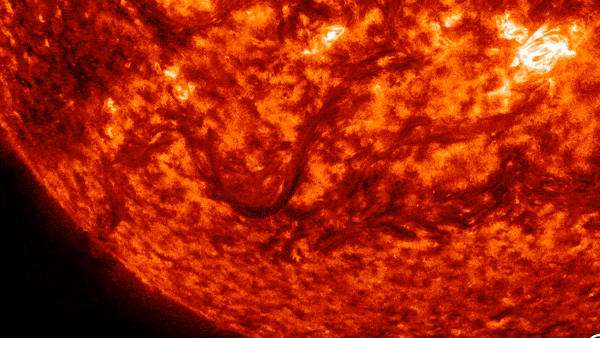Watch a massive 'canyon of fire' explode from the sun (video)
The fiery chasm was at least double the width of the United States.
A vast "canyon of fire" at least double the width of the United States was carved into the sun's southern hemisphere Wednesday (Oct. 31).
The culprit? A large magnetic filament eruption from the sun, according to spaceweather.com. This activity generated a canyon roughly 6,200 miles wide (10,000 km) and 10 times as long.
These solar filaments are colossal arcs of electrified gas, or plasma, that are held suspended above the sun's surface. They snake through the sun's atmosphere, responding to our star's magnetic field. When the magnetic field becomes unstable, the filament collapses, which can result in spectacular explosions — like the one seen in the video above.
Related: Solar maximum will arrive sooner and last longer than previously expected, say
"Notice how it starts moving very slowly and gradually accelerates until it becomes unstable and erupts," solar physicist Keith Strong wrote on X (formerly known as Twitter), following the eruption.
According to spaceweather.com, the eruption resulted in a coronal mass ejection (CME) — where charged plasma from the sun's upper atmosphere, the corona, is hurled into space. NASA models hint at a glancing blow to Earth on Nov. 4.

If at least part of the CME is directed at Earth, the powerful streams of magnetized solar wind could trigger impressive auroras later this week. (The auroras are also known as the aurora borealis or northern lights in the Northern Hemisphere and the aurora australis or southern lights in the Southern Hemisphere.)
Get the Space.com Newsletter
Breaking space news, the latest updates on rocket launches, skywatching events and more!
Auroras are caused by energized particles from the sun slamming into Earth's upper atmosphere at speeds of up to 45 million mph (72 million km/h). Earth's magnetic field then redirects the particles toward the north and south poles.
The electrically charged particles next enter Earth's atmosphere, exciting gas atoms and molecules and generating auroras. The process is similar to how neon lights work: When the molecules and atoms get "excited" by electrons, they must return to their original energy (ground state) and do so by releasing the energy as photons (light). The color of the neon light depends on the gas mixture inside the tube, just like the color of auroras depends on the gas mixture in the atmosphere.
The current aurora season has already put on some dramatic displays and experts predict it will continue to ramp up as we approach "solar maximum" — the peak of solar activity during the approximately 11-year solar cycle.
Join our Space Forums to keep talking space on the latest missions, night sky and more! And if you have a news tip, correction or comment, let us know at: community@space.com.

Daisy Dobrijevic joined Space.com in February 2022 having previously worked for our sister publication All About Space magazine as a staff writer. Before joining us, Daisy completed an editorial internship with the BBC Sky at Night Magazine and worked at the National Space Centre in Leicester, U.K., where she enjoyed communicating space science to the public. In 2021, Daisy completed a PhD in plant physiology and also holds a Master's in Environmental Science, she is currently based in Nottingham, U.K. Daisy is passionate about all things space, with a penchant for solar activity and space weather. She has a strong interest in astrotourism and loves nothing more than a good northern lights chase!









